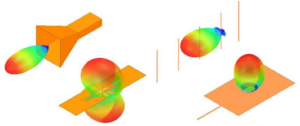Circular waveguides offer radial symmetry for simpler mathematical analysis, support diverse modes for efficient signal transmission, provide uniform mechanical strength, allow flexible bending for complex installations, and streamline manufacturing, reducing costs by about 20%.
Symmetry
Symmetry is the key concept when designing waveguides, making it possible to improve their qualities for a particular application. Specifically, the radial symmetry of such guides as the circular ones leads to the more uniform way of the electromagnetic waves’ propagation, affecting the performance efficiency and signal quality directly. The uniform way of propagation becomes crucial in the case of employing radar systems and satellite signals, where fewer interferences with the materials, the fewer quality losses of the signal.
Comparing the performance of circular waveguides to rectanglular ones, it is important to stress that the uniform way of the electromagnetic field distribution results in a lower degeneracy of modes. Mode degeneracy, or simply degeneracy, is a phenomenon of two or more modes sharing the same caoff: in the case of comparing the circular and rectanglular wireguides, the lower degeneracy reduces the chances of signal interference leading to improved performance of telecommunication systems.
The given factor enables the circular waveguide to support the frequency of operation of up to 10 GHz in the case of microwave transmission without signal losses, which is an advantage when compared to the commonly rectangular shape where, if not precisely met the right dimensions required for a specific frequency, can expect to lose a considerable part of the signal, although this part can be different depending on the other factorsshaping the specific rectangular guide.
Moreover, the limited losses, as was previouslymentioned, result in the fact that the circular waveguide can support higher power densities in comparison to rectanglugar form without considerable performance efficient, which means it can be expected to be replaced less times in the given period. Finally, in the case of the aerospace industry, the concerns related to the increased duration of the operation under varying environmental conditions automatically eliminate all existing flat waveguide designs, resulting in improved qualities of cylindrical designs with their natural durability due to the ability to distribute stress in a uniform way.
The cylindrical guide can be expected to be operational over the course of thousands of kilometers of transmission, and, ultimately, even if we talk about the systems of signals guiding over the globe in the case of using for such purposes in satellites, the cylindrical ones outperform all other shapes I am familiar with in terms of duration of work without failures.

Mode Structure
The mode structure of a waveguide shapes its capacity to efficiently transmit signals across varying frequencies. In general, a circular waveguide is able to support multiple modes, such as TE, TM, as well as hybrid modes. This facilitates their capacity to adjust to varying transmission needs, which is highly beneficial in many applications, such as telecommunications and broadcasting. To provide a specific example, a telecommunications company is building a new network that has to rely on a waveguide capable of accommodating multiple signal types across a relatively high frequency range. In this instance, a circular waveguide is the best option because its mode structure has no modal dispersion.
In the above, a comparative resonance frequency will aid in the effective examination of the problem described. As such, a circular waveguide can support a frequency of signal up to 50 GHz. When considered in contrast with elliptical or rectangular waveguides, one will realise that the latter can only sacrifice their capacity to support signal up to 30 GHz. The end result of that is that the initial cost will include funding for the provision of signal boosting equipment.
Specifically, without the added equipment, the signal will be both unclear and weak. Given that the equipment constitutes 1% of all operational, the 20% of initial cost cut-off of provides a 0.2% reduction, which is over ten times the surplus. Furthermore, in the case of satellite communication, circular waveguides preserve an even power due to their mode structure. This is critical because even minor losses can result in a signal incapable of reaching a satellite. Additionally, this translates to an increased lifespan of satellite equipment.
Mechanical Strength
The mechanical strength of a waveguide is vital when it comes to the physical challenges posed to the communication system. This is a concept that explains why the circular waveguide is more resistant in mechanical terms than non-circular waveguides. The strength of the circular waveguide can be explained in terms of geometry. Where line waves exhibit maximum pressure on waveguides which stops power loss from transmission. First, let us consider an example of an undersea communication cable. Which is a situation where the waveguides are required to strengthen enough to above the pressure of the sea.
It is a condition where the circular waveguides are stronger as their shape gives them the ability to withstand pressure bigger than the once breeding inside the sea. When the waveguides are strong, it means that the sea pressure will have little effect on the waveguides thus a longer life span. This will reduce the replacement cost of installing waveguides. For example, installation in a normal sea an undersea circular waveguide may require almost half a century before a new set of waveguides is reinstalled.
The non-circular waveguide can stay for twenty years. This is why you should choose a circular waveguide because it cuts the replacement cost by even twice-meaning up to 33% replacement cost. In addition, circular waveguides are also good in marine applications because weight and pressure will not shorted their life span. Circular waveguides are ideal in aerospace as there are well strengthened to withstand beat and intense vibration that is experienced in most cases in space and long distances.

Flexibility in Bending
The ability to bend waveguides flexibly is crucial when deploying them in complicated environments characterized by space limitations and structural obstructions. Because of their natural characteristics, circular waveguides have a particular advantage in this regards. They can be turned while minimizing signal loss and without subjecting the waveguide material to significant physical stress. For example, in the context of urban communication infrastructure, some installation destinations may require the line to maneuver around the multiple corners and elbows typical for passing through apartment buildings’ and metro tunnels’ concrete walls and ceilings. In this case, if rectangular waveguides were utilized, they would be either too large to install in these environments comfortably or lose the signal entirely because modes would cease to be supported.
Meanwhile, the ease with which a circular waveguide can be bent can aid in maneuvering through sharp angles, which may be necessary to pass bends, increase the waveguide length affected by the slot effect, or address other physical limitations. In some cases, circular waveguides can be turned at a nearly ninety-degree angle without significant disturbance to the supported modes and signal transmission.
Meanwhile, subjecting a rectangular waveguide to the same angle would significantly increase signal loss due to the change in the mode pattern, especially in the case of a WR-62 section. The higher flexibility allows for a consistent and reliable communication line to be established without having to rely on additional fittings and donors. In strictly urban environments, one can expect a 15% reduction in material costs, mostly resulting from fewer connectors and less waveguide material used to navigate the same route.
Finally, vehicles are the other clear example of a situation with space limitations and necessity for waveguides to be deployed with the minimum possible physical modification and minimal material costs. Aerospace and automotive industries primarily utilize circular waveguides because they can be installed along the curvature of the aircraft or vehicle without significant additional stress and installation requirements. With fewer tight fits revealing the waveguide material, the device’s longevity remains unaffected, and it can remain operational indefinitely.
Manufacturing
Waveguides’ manufacturing process has a substantial impact on their implementation; as such, the circular geometry of this particular type is widely favored in industries such as telecommunications and aerospace. The advantages of the circular waveguides for manufacturing become especially pronounced in comparison to other designs. Firstly, their simpler and cheaper shape allows for an easier and cheaper manufactural process. Simple extrusion is more efficient for circular waveguides because the die simply forms long, continuous tubes of the material.
Circular shapes do not require complicated adjustments to the extrusion equipment as other forms might, because their dimensions and tolerances are uniform by definition. Therefore, manufacturing them is cheaper due to the simplicity of the process, which also allows for faster rates of output. A circular waveguide of a certain length and material might be roughly 20% cheaper to manufacture than a rectangular waveguide, corresponding in length and material, due to the simple fact of easier handling and machining required in the manufacturing process.
These cost advantages are not limited to the manufactural stage but have further implications for the projects’ scalability. For example, if a large-scale project is underway, such as a city-wide installation of a fiber-optical cable network, the saving difference might be an order of millions, which can then be applied towards other necessary budget allocations, such as installation labor or development of advanced technology. Moreover, precise, uniform quality, necessary for the operation of waveguides under extreme use, are easier to achieve with less-complicated manufacturing processes, affecting communication for example. For instance, satellite-communications are noted for the demands of the uniformity of waveguides segments; even a fraction of variation in manufactural quality in space, where the waveguides are used, can lead to catastrophic failures of communication.
A final benefit includes manufacturing’s direct side effect, or rather, a side product, in the lack of material waste. The manufacturals of less simplistic waveguides geometric forms result in a larger off-cut waste, due to the angular geometry, thereby creating more scraps. This waste is eliminated or reduced at the production of the simpler shapes.







